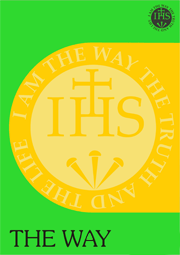|

| |
FROM DEATH TO LIFE
Please click here to subscribe to The
Way, Electronic subscribers, click here to download this issue. You will need the password that we e-mailed to you. Contents George B. Wilson What really happened at Calvary? The events surrounding the crucifixion are re-examined from the perspective of a contemporary witness, helping us better to understand who Jesus was, and is. Lillian Craig Harris A series of research visits to Second World War cemeteries in Tunisia prompt reflections on how different cultures sharing the same history deal with death and bereavement, and the lessons that we can learn from them about death and about eternal life. Ian Bell Asceticism receives a bad press among contemporary enlightened Christians. But there is wisdom in the Church's ascetical tradition that we should not lose. Ian Bell explores how the human body can communicate spiritual meaning symbolically. An unknown Monk of Montserrat While in general the debt owed by St Ignatius to the Abbey of Montserrat has always been acknowledged, a new publication may help to bring greater precision, and reveal the roots of ‘Ignatian’ techniques of prayer. Ignatius Jesudasan The rituals of the Church and the dates of the liturgical calendar reinforce our Christian identity. This article explores the links between baptism, the mystery of Easter and the forgiveness of sins for Jesus himself, for the Church, and for all Christians. George Aschenbrenner The resurrected presence of Jesus is a source of joy and hope, especially to those who are grieving. Our relationship with the risen Christ is explored in the context of the grace of Ignatius' Fourth Week. Download this article in
Word format by clicking here, Karen Eifler The Roman soldiers who mocked Jesus and placed a crown of thorns upon his head must inevitably have wounded their own fingers in the process. A personal reflection on the pain inflicted on ourselves by our own wrongdoing. Book Reviews on the problem of evilon Bernard Lonergan on Jesuit sites in Beijing on theology within the university on petitionary prayer and the three-personed God on theology and the family on bioethics on contemplation on Shakespeare, on icons and on the Rosary on religion and the public sphere on four gospel studies on James Loder on a new collection of essays by James Alison on two new books by wise religious sisters on mysticism in medieval Germany on green sisters on the study of Christian spirituality and on becoming a Catholic From the Foreword The policy of The Way under the guidance of Philip Endean has been to provide original viewpoints on questions that affect the spiritual life of its readers. We are grateful to him for all his work over the last five years as editor. Philip has now unfortunately relinquished the editorship, at least temporarily, because of his health, but this issue, though lacking the benefit of his final ‘polish’, is largely a result of his initiative, as becomes obvious as one examines the table of contents.In this issue, both George Wilson and Karen Eifler look explicitly at aspects of the passion; unlike those who become obsessed by the physical pain that Jesus suffered, both are able to see further and find themselves reflected in that mirror. Similarly the emotional impact of a series of cemetery visits by Lilian Craig Harris takes on a wider significance, while the apparent despair that wells up in the experience of bereavement can find a deeper meaning when joined to the Risen Lord (George Aschenbrenner). The phenomenon of voluntary suffering, that ascetical tradition that recurs so constantly in different forms of religious life, is again in need of being examined with new eyes (as by Ian Bell) and seen as a symbol of the role of the body in one’s loving relationship with God. Finally, as Ignatius Jesudasan points out, at the heart of the Lenten ritual is the uplifting, life-giving experience of forgiveness, surely the key message of Christ’s First Coming among us. The happy chance of a visit to Spain last February allowed me to become acquainted with the recently published Compendio drawn up by a monk of Montserrat as a handy reference manual to the book of ‘Exercises’ written by his abbot. The links with St Ignatius remain hypothetical: the literary style is very different, and much of the teaching is simply a distillation of the devotio moderna that was common parlance at the start of the sixteenth century. However, the short chapter is so obviously ‘sound’ in its teaching, and so firmly rooted in both tradition and experience, that it well repays being read anew with fresh eyes; hence it is this issue’s contribution to ‘From the Ignatian Tradition’. For Ignatius the visit to Montserrat certainly symbolized a transformation from death to life. Joseph A. Munitiz SJ
Please click here to subscribe to The
Way, | ||
| |






|


